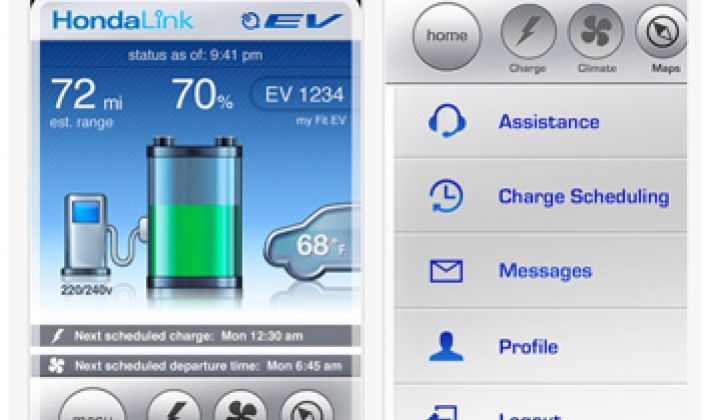Onboard internet-connected telematics are becoming the norm in new vehicles rolling off production lines, offering everything from Facebook access to real-time navigation.
Many of the features are nice, but not critical, for the driver of an average car. But for electric vehicles, apps take on a new importance to help drivers manage their range (anxiety) and charging schedule.
Honda’s Fit EV comes with HondaLink EV, a platform developed by Agero that is specifically designed to enhance the EV experience. It comes with many of the bells and whistles of its regular HondaLink offerings, which come standard on other vehicles like the Accord, but also allows for vehicle charging management and mapping driving range. The Honda Fit EV will initially only be available in California and Oregon.
“We’re facing a lot of potential unknowns in terms of customer acceptance of a new technology, so we need to provide multiple interfaces to ensure we’re delivering a high level of knowledge and comfort to Fit EV owners,” Charlie Cavolina, president, Agero Connected Vehicle Services, said in a statement. “Likewise, it’s a platform that also must quickly provide vehicle manufacturers with immediate feedback from owners so that next-generation systems can be quickly adapted.”
Getting the dashboard right is no small deal. It could be the difference between widespread acceptance of all-electric vehicles, or the cars remaining a niche purchase. Earlier this month, CNN Money reviewed the Fit EV driving experience and, in addition to the fun driving experience that most EVs offer, noted that the real benefit was its panel that clearly displayed estimated range based on a variety of factors.
Agero knows that providing the right information is a moving target, especially for EVs, with which drivers are looking for a lot more than the right mix of satellite radio offerings. In the future, Agero sees the HondaLink as also being able to be used so that the car’s battery could power the house, if necessary, or send power back to the grid.
Currently, vehicle-to-house (or -grid) is hardly a reality. Honda is working with IBM and Pacific Gas & Electric to connect HondaLink to PG&E’s back office. Currently, it’s mostly a software test with simulated scenarios. Fewer than 10 cars are part of the pilot. The project is testing the signal that could tell the car to stop charging. Duke Energy is also teaming up with Toyota on a pilot with the electric Prius.
It will still be many years before EV owners would let utilities’ use their cars as part of demand response programs. For now, the question is still whether all-electric (or even EV and plug-in hybrids) will become a meaningful part of the driving landscape.



